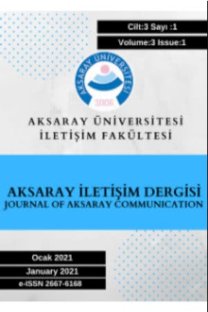Bireyden Topluma Dilin İşlev ve Özellikleri
Bu çalışmada iletişim alanında yapılacak olan “dil” temalı çalışmaları destekleyebilmek amacıyla dilin işlev ve nitelikleri bireyden başlanılarak toplumsal boyuta genişleyen bir biçimde tartışılmaktadır. Birey açısından dil duygu ve düşünceleri aktarmayı sağlayan bir araç görevi görmenin beraberinde toplumsal role uygun davranabilme, gelenekleri öğrenebilme ve yabancı kültürler ile entegrasyon gibi süreçlerde kilit rol oynamaktadır. Bu rolün anlatılabilmesi adına çalışmanın bireyler ile ilgili olan başlıklarında dilsel yeterlilik, kültürün etkisi, sosyal roller ve yorumlama süreçleri incelenmiştir. Toplum açısından ise çok daha geniş boyutlarda bir arada yaşayabilme pratikleri, anlamın inşası ve dilin değişken yapısına değinilmiştir. Bu sebeple toplumsal boyuta ilişkin bölümlerde ise; dilsel sınırlar, kalıplar ve inşa edilen tüm sosyal gerçeklikler belirleyici roller gibi temalar incelenmiştir. Dilin bu şekliyle hem birey hem de toplum açısından ele alınmasının iletişim alanında yapılacak olan “dil” çalışmalarında başvurulabilecek temel tartışmalara erişilebilmesi açısından önem arz ettiği düşünülmektedir.
Functions and Features of The Language: From Individual to Society
In this study, in order to support the "language" themed studies in the field of communication the functions and features of the language are discussed in an expanding manner to the social dimension starting from the individual. For individuals, in addition transfering emotions and thoughts, language plays key roles in reflecting social role, learning about traditions and integration with foreign cultures and so on. In order to explain this role, linguistic proficiency, the effect of culture, social roles and interpretation processes were examined in the topics of the study related to individuals. On the other hand for society, the practices of coexistence, the construction of meaning and the variable structure of the language are examined. For this reason, in the sections for society; themes such as linguistic boundaries, patterns, and determining roles of all social realities built were examined. It is thought that handling the language by both individual and society is important in terms of accessing basic discussions that can be used in language studies in the field of communication.
Keywords:
language, communication, individual society, culture,
___
Anık, Cengiz (2020). Bilimsel Çalışmaların Rotası, (Derleyen) Cengiz Anık. Dijital Medyanın Ekonomi Politiği Ankara: Nobel Yayınları, s. 26-66Britain David ve Matsumoto Kazuko (2005) Language, Communities, Networks and Practices Editör Ball, M. J. Clinical sociolinguistics. John Wiley & Sons, s. 1-28
Cohen Anthony P. (1999). Topluluğun Simgesel Kuruluşu (Çev. Mehmet Küçük) Dost Kitabevi: Ankara
Duranti, Alesandro (1988). 12 Ethnography of speaking: toward a linguistics of the praxis. Linguistics, the Cambridge Survey, 4, 210.
Garfinkel, Harold (1967) Studies in Ethnomethodology. Englewood Cliffs, NJ: Prentice
Goffman, Erwing (1959). The presentation of self in everyday life. New York: Doubleday.
Gumperz, John Joseph (1984). Communicative competence revisited. (Editör) Deborah Schiffrin. Meaning, Form, and Use in Context: Linguistic Applications, Washington, DC: Georgetown University Press, s. 278–289.
Hymes, Dell (1961). Functions of speech: an evolutionary approach. (Editör) Frederick C. Gruber. Anthropology and Education, Philadelphia: University of Pennsylvania Press, s. 55–83.
Hymes, Dell (1966). On communicative competence. Paper presented at the Research Planning Conference on Language Development among Disadvantaged Chil¬dren, Yeshiva University.
Hymes, Dell (1972). Models of interaction of language and social life. (Editörler) John J. Gumperz ve Dell Hymes. Directions in Sociolinguistics: Ethnography of Communication. New York: Holt, Rinehart & Winston, s. 35–71
İngeç, Ali Kerem (2020). Mahremiyetin İğfali, (Derleyen) Cengiz Anık. Dijital Medyanın Ekonomi Politiği Ankara: Nobel Yayınları, s. 336-348
Jacoby, Sally ve Ochs, Elinor (1995) Co-construction: An introduction. Research on Language and Social Interaction, 28(3), s. 171-183.
Labov, William (1972) On the mechanism of linguistic change. (Editörler) John J. Gumperz ve Dell Hymes, eds, Directions in Sociolinguistics: The Ethnography of Communication,. New York: Holt, Rinehart & Winston. s. 512–38
Labov, William (2001) Principles of Linguistic Change: Social Factors. Oxford: Blackwell.
Lyons, John, (1970). New Horizons in Linguistics. Harmondsworth: Penguin.
Mead, George Herbert (2015). Mind, self, and society: The definitive edition. University of Chicago Press.
Parsons, Talcott (1951). The social system. New York, NY: The Free Press.
Santa Ana, Otto ve Parodi, Claudia (1998). Modeling the speech community: configuration and variable types in the Mexican Spanish setting. Language in Society 27: 23–51.
Saville-Troike, Muriel (2008). The ethnography of communication: An introduction (Vol. 14). John Wiley & Sons.
Sherzer, Joel (1975). Ethnography of speaking. Manuscript, University of Texas at Austin.
Sinclair, John (2008). Borrowed ideas. (Editör) Brill Rodopi. Language, People, Numbers, s. 21-41
Soncu, Ayşegül (2020). Ruhu Çalınan Değerlerin Gösterisi, (Derleyen) Cengiz Anık. Dijital Medyanın Ekonomi Politiği Ankara: Nobel Yayınları, s. 293-306
Sternberg, Robert J. ve Sternberg, Karin. (2012). Cognitive Psychology (6th ed.). Belmont, Calif: Cengage Learning.
Theune, Mariet, Antinus Nijholt, ve Hendri Hondorp (2002). Language and Computers: Studies in Practical Linguistics.
Türk Dil Kurumu Güncel Türkçe Sözlüğü Erişim Adresi: https://sozluk.gov.tr/ Erişim Tarihi: 26.02.2019
- Yayın Aralığı: Yılda 2 Sayı
- Başlangıç: 2019
- Yayıncı: Aksaray Üniversitesi
Sayıdaki Diğer Makaleler
Umudun Öteki Yüzü Filminin Göstergebilimsel Çözümlemesi Bağlamında Mültecilik
YAKINSAMA KÜLTÜRÜ VE TRANSMEDYA HİKÂYE ANLATICILIĞI ÜZERİNE
Mahmut AKGÜL, Hande HEKİMOĞLU TOPRAK
Bireyden Topluma Dilin İşlev ve Özellikleri
Cengiz ANIK, Mustafa Cankut KURT
Halkla İlişkiler Perspektifinden Şehir Markalaşması ve Sakin Şehir (Cittaslow) Modeli
Yeliz KUŞAY, Duygu KOTAN TÜRKDEN
Erasmus Öğrencilerinin Sosyal Medya Kullanımları Ve “Anı Kaçırma Korkusu” (FoMO)
Ekşi Elmalar Film Afişi Üzerine Göstergebilimsel Bir Deneme
Sosyal Medya Çağında Dijital Emek Kavramı ve Bir Ticari Medya Platformu Olarak Google
